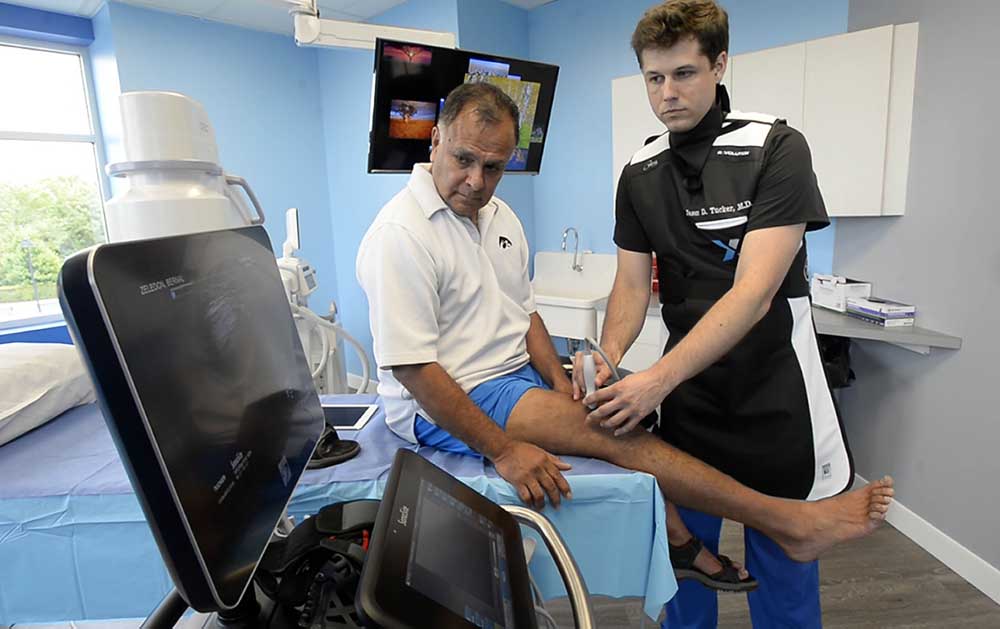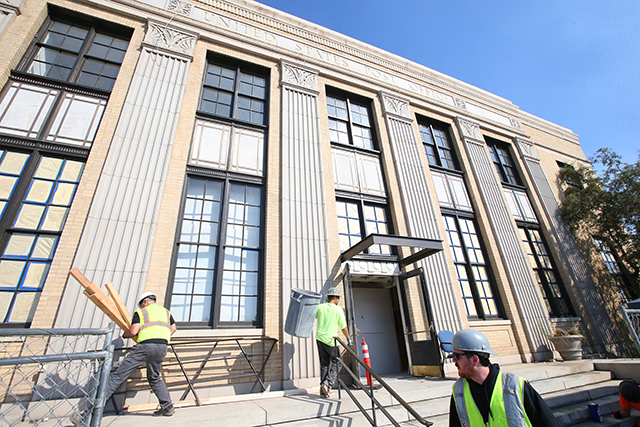Pro athletes, others try PRP, stem cell injections for joint pain
Published 12:00 am Thursday, December 1, 2016

- Dr. Jason Tucker of OrthoBiologix uses an ultrasound to check the progress of Bernie Zeledon weeks after having Bilateral Stem Cell treatment of the knees, during a followup visit. The treatment is becoming a more common option for joint pain rather than surgery.David T. Foster III / The Charlotte Observer
CHARLOTTE, N.C. — It’s been 18 years since Bernie Zeledon injured his knee while playing soccer with his kids. His doctor recommended surgery, but Zeledon didn’t want to risk infection or face a long recovery. So, he put up with the pain, took ibuprofen several times a week and walked around “like a little old man.”
But in July, Zeledon, now 60, read about a new clinic in Charlotte, iOrthoBiologix. It offers nonsurgical therapies for joint pain, including injections of platelet-rich plasma, derived from a person’s own blood to promote healing of tendon and muscle injuries and arthritis.
Trending
Zeledon knew the treatment was popular with professional athletes, such as Tiger Woods, Kobe Bryant and Peyton Manning. So, he called for a free consultation.
Two days later, Dr. Jason Tucker treated both his knees on the same day. And two weeks later, the swelling around Zeledon’s knees was down, he walked steadily with braces and felt no pain.
Platelet-rich plasma therapy, known as PRP, first gained widespread attention in 2009 when players for the Pittsburgh Steelers — Hines Ward with a sprained knee ligament and Troy Polamalu with a strained calf — had the injections, recovered quickly and went on to play in the Super Bowl.
That news led to demand from weekend warriors. And sports medicine doctors obliged, even though research to support the therapy was still thin.
In Charlotte, a few orthopedic practitioners, who offered PRP even before that Steelers moment, have been low-key about it, careful not to over-promise on results. But in the past year and a half, PRP — and a newer injection therapy using stem cells — have taken on a higher profile in Charlotte.
New providers are marketing “regenerative” or “bio-restorative” medicine as an alternative to joint replacement surgery.
Trending
• Flexogenix opened a SouthPark clinic, one of three clinics in North Carolina, in August 2015. Its full-page ad in the Observer says “regenerative therapy can stimulate new cell growth, regenerate new cartilage and accelerate the body’s natural process to rebuild tissue and heal itself.”
• iOrthoBiologix, which opened this summer in Ballantyne, was featured in a recent Men’s Health magazine about the benefits of stem cell therapy: “The idea is that you’re giving your own body more healing potential by using your own restorative stem cells and growth factors.”
• Atlas Integrated Healthcare, a chiropractic clinic in Matthews, touts owner Michael Schmitt’s “miraculous recovery” from knee pain after stem cell injections. Its full-page ad says the procedure “can literally repair and regenerate tissue in the body that has been damaged by age, disease or degeneration.”
As hopeful as this sounds, these therapies remain controversial in the medical community. They are also expensive — maybe several thousand dollars per injection — and insurance does not cover them.
Dr. Pat Connor, an OrthoCarolina surgeon and team physician for the Carolina Panthers, the Charlotte Knights and Joe Gibbs Racing, offers PRP to some patients. But he warns, “It’s important to balance hope versus hype.”
Research in the United States and Europe has produced contradictory results. Some show symptom improvement; others show the treatment is no better than placebo. Even doctors who believe PRP and stem cell injections relieve pain disagree whether it can regenerate tissue.
“The marketing gets ahead of the science,” said Dr. Scott Rodeo, an orthopedic surgeon at the Hospital for Special Surgery in New York City. “There is great potential there. But we need more data … I’ve seen a number of disappointed patients who’ve spent a lot of money. … It may help, and it may not help.”
Dr. Sean Whalen, a Flexogenix cofounder who used to work in Gastonia, North Carolina, said there is “plenty of research that supports the effectiveness of PRP alone or in combination” with other therapies. Much of the skepticism comes from “old guard” orthopedic surgeons, he said, who are threatened by change that would reduce demand for surgery.
“Go back to (the introduction of) laparoscopic surgery,” Whalen said. “It was called the ‘snake oil of surgery’ at the time. Now, of course, it’s widely accepted, and it’s even the standard of care.”
Tucker, the founder of iOrthoBiologix, also disputes the doubters. He’s seen positive responses in patients, and cites a long list of studies, including his own, to support the benefits of PRP and stem cell injections.
“People that say there is no evidence for this,” Tucker said, “are categorically wrong.”








